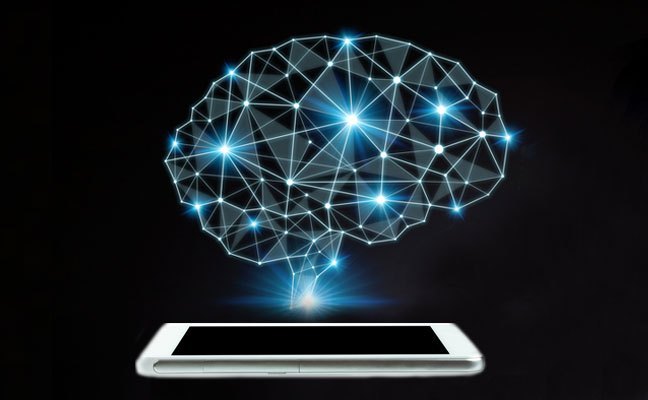 When following a patient for brain tumor recurrence, standard assessments fall short: Imaging and clinical exams each occur only a few times per year, and patient questionnaires capture only a moment in time and may be unreliable due to the challenge of accurate self-assessment amidst insidious decline.
When following a patient for brain tumor recurrence, standard assessments fall short: Imaging and clinical exams each occur only a few times per year, and patient questionnaires capture only a moment in time and may be unreliable due to the challenge of accurate self-assessment amidst insidious decline.
Timothy Smith, MD, PhD, MPH sees a solution in each patient’s pocket. He is investigating the ability of smartphone data to expose subtle behavior changes that could lead to early detection of glioblastoma (GBM) and improved treatment and quality of life.
“We can use smartphone data to map neurocognitive function,” said Smith, a neurosurgeon in the Brigham and Women’s Hospital Department of Neurosurgery co-directs the Computational Neuroscience Outcomes Center (CNOC) @Harvard, which focuses on neurosurgical applications of artificial intelligence (AI) and is based in the hospital’s Department of Neurosurgery.
What a Smartphone Can Reveal about Cognitive State
Metadata that relates to the simple act of responding to a text, accrued over time and many texts, can be revealing. “If cognitive reserve has been depleted by a tumor, you may not be responding to texts as quickly, and what you say may be different,” explained Smith. A subtle decrease in executive function may make it difficult to navigate the competing stimuli of daily life and affect the decision of whether and when to respond. Then, orchestrating the response requires engagement of the visual and motor systems and language stem. Combining multiple data streams can build a model of cognition, he said.
Smith and colleagues have enrolled 450 patients whose GBMs were resected at the Dana-Farber/Brigham and Women’s Cancer Center. Data being collected through their smartphones includes call log mapping, voice recordings, texting frequency and response time, language use and GPS indications of frequency and distance of travel.
“We’re looking at how long does it take you to craft this text, how many mistakes did you make when you texted, how many times did the autocorrect engage, what is your lexicon, what vocabulary are you drawing from, what’s the grammar of this sentence that you are making, what is the semantic content? — and is it changing over time?” Smith said. “We don’t need to add anything extra onto the phone to build a health profile or a model of your cognition — no games, no survey.”
Smith’s team uses the Beiwe Research Platform, developed by J.P. Onnela at the Harvard T.H. Chan School of Public Health, to collect and analyze moment-by-moment behavioral data from an individual’s smartphone, creating a “digital phenotype.”
Given the sheer volume, velocity and variety of this data, finding a signal and not making spurious associations is a challenge. “Classical statistical maneuvers just break down with this volume of data,” Smith said, “which is why AI becomes so important.”
Smith’s goal is to use smartphone data to develop AI algorithms that would alert doctors and patients early to disease progression and treatment side effects, ultimately improving quality of life, minimizing treatment complications and prolonging survival.
Knowing A Patient’s Quality of Life Before the Visit
An important benefit of collecting passive data from a smartphone is decreasing the burden on the patient, by eliminating long surveys and making appointments more useful.
“We suspect that this kind of behavioral data will, in a much more nuanced and proficient way, anticipate true recurrence long before we even see it on MRI,” Smith said. “I’d love to be able to tell the patient how they’re doing before they arrive [at an appointment].”
If further treatment is possible, it can begin earlier. For GBM recurrence that cannot be treated, the information about disease progression can help patients and families address quality of life and planning.
Smith’s CNOC team is engaged in similar projects relating to spine surgery, psychiatric illness (depression and schizophrenia) and addiction. For major stroke, they are investigating data from the months prior to the stroke to determine whether evidence of TIAs could be predictive.
A recent study showed that patients with spine disease who reported greater pain also had reduced mobility, as measured by smartphone GPS data, which suggests “a promising and scalable approach to assess mobility and quality of life of patients with spine disease,” Smith and co-authors wrote in World Neurosurgery in early 2019.
Meanwhile, Smith is seeking to expand his 450-patient GBM study at Brigham and Women’s to other sites in Europe. More data would contribute to a more reliable interpretation of how behavior relates to tumor progression.
While patients seem to embrace the collection and use of smartphone data (only two patients declined to enroll in the ongoing GBM study), some physicians are raising questions about who might own, manage or access the data. These are questions to tackle as we stand on the cusp of a new stage of assessment in neuro-oncology, said Smith, describing the progression from RANO (Radiological Assessment in Neuro-oncology) to NANO (Neurological Assessment in Neuro-oncology) and soon DANO (Digital Assessment in Neuro-oncology.)
“There will be several ethical dilemmas to face,” said Smith. “But digital healthcare is coming, so we need to face and address these questions.”